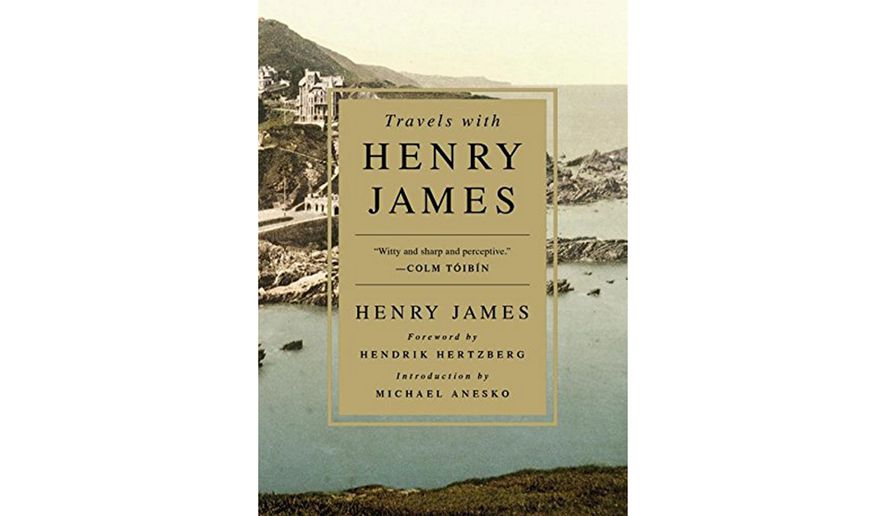OPINION:
TRAVELS WITH HENRY JAMES
By Henrik Hertzberg
Nation Books, $19.99, 278 pages, illustrated
Henry James is one of those authors whom it is hard to imagine as a young person. Somehow the picture that flashes into the mind about him is of a stout, bald man poised between an extended middle age and being outright elderly. Perhaps this is because so many of the novels we remember him for now, like “The Ambassadors,” “The Golden Bowl” and “The Wings of the Dove,” were written when he was indeed middle-aged, but even earlier works, like “Portrait of a Lady” or “Daisy Miller,” seem to possess — for good or ill — a gravitas beyond his years.
Only “Daisy Miller” (1878) falls within the temporal purview of this charming collection of travel pieces James wrote for magazines in the years literally spanning the decade: the first one on Saratoga from 1870 and the last on London theaters from 1879. As The New Yorker’s Hendrik Hertzberg writes in his brief but perceptive foreword: “Henry James was, almost literally, a born traveler. He was barely six months old in October 1843, when, with his family, he crossed the Atlantic for the first time . He made four more crossings in his teens, attending a bewildering variety of schools, studying with a succession of private tutors, and making himself a bilingual habitue of London, Paris and Geneva. In the 1860s, he was back in the United States, mostly in Boston and Cambridge. He didn’t return to Europe until 1869, this time as a full-grown man and emphatically on his own, for fifteen months of intensive travel.”
The effect of this unusually cosmopolitan upbringing and young manhood was to enable him, even at the outset of his long career, to look on both his native land and Europe with a preternatural combination of ingrained familiarity with an outsider’s perspective. A unique combination that flowered into the truly trans-Atlantic sensibility, which distinguishes so much of his fiction.
So it is no surprise to find him able to comment with equal ease on the theaters of London and Paris, the spa towns of Saratoga Springs in New York and Hamburg in Germany, “The After-Season at Rome” in 1873 and, five years on, “London in the Dead Season.” In these pieces, he is always acutely perceptive and original, and he can be just as much so in more bucolic settings, from upstate New York’s Lake George and Burlington, Vermont to North Devon in England. The Henry James of the 1870s does not just turn his attention to seasons in the social sense but is very much attuned to the actual ones as well, with no less than a quintet of summers, in England, France and Italy and an autumnal Florence. In his article on Scotland, he views not only its historic sights, but dons the lenses of the English who see it largely as a summer location for deer stalking and other forms of sport with the shotgun.
Mr. Hertzberg comments, “For readers of these Jamesian postcards, then and now, there is welcome relief from the news of the day. The tribulations of war and politics and revolution almost never intrude, and when they do, it is only in a passing reference or offhand phrase.” He goes on to quote some examples, but I would take slight issue with this as a generalization, largely because of piece called “An Ex-Grand-Ducal Capital.”
He wrote it in 1873, two years after the Franco-Prussian War had finally achieved the long-sought unification of Germany, much to the delight of victorious Prussia and the anguish of vanquished France. But the newly established German Empire had enfolded into itself many a lesser royal house, including that of the Grand Dukedom of Hesse, one of those unfortunate losers. Although James is a perfectly happy “lounging American” in its charming capital, he is acutely aware that Hesse being ” ‘ceded’ to Prussia” is not without a certain sting to its rulers and citizens alike. When the conquering German emperor rides triumphantly through the streets, James observes tartly:
“I don’t know whether he saw any reproachful ghosts there, but he found, I believe, a rather scanty flesh-and-blood welcome in the town.”
Mr. Hertzberg says that in “Travels with Henry James,” “We are traveling for pleasure, and pleasure is what James gives us.” True, but he is anything but a blithe, blinkered cicerone. A reliable, if subtle, guide not just to outward sights but to what lies around and beneath them.
The publishers of this book have put a photograph of a youngish-looking Henry James on its jacket, but even then there is no hair atop his head and he seems to be looking pensively toward ever-greater maturity. There’s ponderousness alongside the sprightly in these pages, his sentences are already elaborate. But there is also wisdom beyond their author’s age and those sharp powers of observation which are an abiding Jamesian hallmark.
• Martin Rubin is a writer and critic in Pasadena, Calif.




Please read our comment policy before commenting.